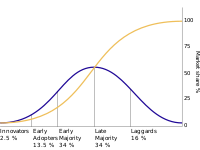
Photo from wikipedia
This special issue on ‘methodologies in innovation studies’ is the outcome of the first Globelics Academy alumni meeting held in Tampere, Finland, in May 2015. Globelics Academy (an international PhD… Click to show full abstract
This special issue on ‘methodologies in innovation studies’ is the outcome of the first Globelics Academy alumni meeting held in Tampere, Finland, in May 2015. Globelics Academy (an international PhD school on innovation and development) aims to support the training of PhD students who, in their dissertations, utilise an innovation systems approach in the context of emerging or developing economies. There is no single definition of an innovation system. To date, two of the key authors in the field have introduced fairly different approaches in some important respects. Richard Nelson focuses on the innovation system in a narrow sense, basing the main theoretical tools on law and economics. In his work, the role of institutions in solving the private/ public dilemma of information and technical innovation is crucial. In the work of Christopher Freeman, the focus is on the interaction between the production system and the process of innovation, and his theoretical grounding is based on a combination of organisation and innovation theory. In this work, relations between organisational forms and innovation are central (Lundvall 2016, 102). However, despite this endogenous diversity, the innovation system approach can be considered to be a social science theory. According to Lundvall (2016), ‘in social science, a theory should be regarded as a focusing device – no more and no less.’ The innovation system as a focusing device helps us to interpret key institutions and processes in the economy (e.g. market, firm, law) differently from the perspective of mainstream economic theory (Lundvall 2016, 4). An innovation system has also been applied as a focusing device at various spatial levels (e.g. cluster, sector, regional, national), and each level provides a somewhat different view of the phenomenon and relevant units of analysis. Among the Globelics community, the national innovation system is the most frequently used concept, but it is by no means overwhelmingly dominant. According to early definitions of the national innovation systems approach, ‘understanding the linkages among the actors involved in innovation is key to improving technology performance. Innovation and technical progress are the result of a complex set of relationships among actors producing, distributing and applying various kinds of knowledge’ (OECD 1997, 9). As the reader may have already anticipated, we are exploring a multi-disciplinary field that is also open to various methodologies. Therefore, particularly in innovation studies, it is important to understand how the specific methodology emerges from the theory. How does this method fit with exploring the research problem in question? Also, although it is common that a variety of methodologies are valid for providing the answer to the same research question, it is important for the reader to understand what method was used and how the research process produced the results provided. Different methods provide different results. Further, there should be a valid reason for using a specific method and this should be openly explained: what will this specific method reveal about the phenomenon that would otherwise remain hidden? Importantly, unreliable or fuzzy methodologies are likely to produce unreliable and fuzzy results. Obviously, this seriously depreciates the value of the research work and its scientific weight. Globelics is a multi-disciplinary community, and, in addition, among its members the focus of an innovation system approach is strongly on transition economies and developing countries. This calls for more considerations in terms of methodologies applied. For example, Lundvall (2005) – already more than decade ago – suggests that, in the case of less developed countries, surveys might be very challenging tools for gathering data to understand what happens inside firms; registered data may also be scarce and unreliable for this purpose. Further, the standard STI indicators may not be the most accurate way to study and understand innovation systems. Alternative indicators and new data gathering methods may be needed (e.g. students as scouts, mini-questionnaires). In terms of data gathering, the public sector and its technological infrastructure are likely to be much easier targets. However, the interaction between the knowledge infrastructure and firms is one of the key elements to understand and analyse in this context (Lundvall 2005, 31). Obviously, there are always challenges in gathering valid data and choosing the right methods. However, scientific methods are tools for researchers. If the researcher has the capability to master various tools, it is likely that they are able to provide more comprehensive and profound answers to increasingly complex research questions. While the individual researcher has limited resources to acquire sufficient competences to master an infinite number of tools, the research community should welcome this challenge and add a sufficient selection of tools to the toolkit of its members. Nonetheless, according to Jungmann, Baur, and Ametowobla (2015), in innovation studies there prevails a dualism ‘as deductive macroand inductive micro-analysis spans a narrow empirical corridor... in which studies of innovation have to be situated to get recognised as such by the research community’. They suggest that ‘a methodological self-restriction of the researchers’ emerges from these institutionalised theory and method schools. Consequently, this narrows down theoretical and methodological resources used to understand the complex questions in innovation studies. They also list some shortcomings of current research practice in innovation studies. Firstly, they point out the narrow range of data. Data are
Journal Title: African Journal of Science, Technology, Innovation and Development
Year Published: 2019
Link to full text (if available)
Share on Social Media: Sign Up to like & get
recommendations!